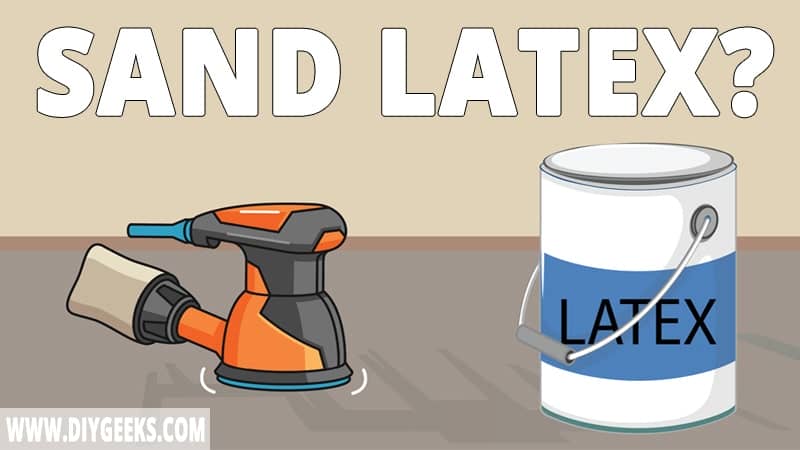Sanding removes imperfections and bumps from the surface, allowing the paint to stick to an even and clean surface.
You must sand before applying latex paint, especially if the surface is already sealed or has imperfections. You must sand between latex paint coats to improve the adhesion of the coats and create a smooth finish.
You shouldn’t sand the final latex paint coating unless you want to seal or paint over it. Sanding the final coating will remove the colorful and bright finish and scratch it.
How Long Must Latex Paint Dry Before Sanding?
Latex paint must dry for 3 hours before sanding. This gives the coating enough time to hard so it can withstand the abrasive side of the sandpaper.
Latex paint solvent (water) must evaporate from the coating for the paint to dry. Once the solvent evaporates, the paint particles start to harden and the coating becomes rigid enough to withstand a sandpaper.
If you sand latex paint before it dries, you will ruin or remove the entire finish. The coating will be wet and weak and the sandpaper will remove it if the solvent hasn’t fully evaporated.
To know if the finish is dry enough for sanding, feel the texture using your hand. If the finish feels dry and textured, it means it has dried, and you can sand it. If the coating texture feels wet and it sticks in your hand, it hasn’t dried (yet), and you can’t sand it.
You can also use fine-grit sandpaper to know if the finish is dry or not. Swipe it over the coating; if the sandpaper starts to clog, it means the paint isn’t dry yet. If it goes smoothly over the coating, the paint is dry, and you can sand it. You must use fine-grit sandpaper for this and not coarse sandpaper.
Do You Need To Sand Before Applying Latex Paint?
You need to sand before applying latex paint to get a better finish and help the paint stick better. Sanding will remove imperfections, dirt, dust, and existing finishes (if any) from the surface and create a layer that helps the paint to stick.
Latex paint has impressive bonding qualities, but it won’t stick over dirty, dusted, or glossy surfaces. Latex paint doesn’t stick over oil-based paint or a glossy sealer, so you must sand the surface to remove the existing finish first.
A sealer, such as polyurethane, forms a thick glossy moisture-resistant layer that prevents paint (especially water-based) from sticking over it. Coarse or medium-grit sandpaper will remove the existing finish from the surface.
You can apply latex paint without sanding if the surface is painted with water-based paint and has no imperfections. Simply clean the material with a rag and apply the paint.
Do You Need to Sand Latex Paint Between Coats?
You need to sand between latex paint coats to improve the adhesion between coats and get a smooth and even finish.
While one coat of latex paint is drying, dust and nibs will settle over it — if you don’t remove or sand off these imperfections, the finish will have bubbles and bumps.
Sanding removes dust, dirt, and imperfections from the existing coating and creates a smooth and even layer for the next coating to stick to.
Use fine or extra fine-grit sandpaper (220-440 grit) to sand between coats of latex paint. Avoid using coarse or medium-grit sandpaper as it can remove the entire finish.
Note: You can skip sanding if the existing coating doesn’t have imperfections, dust, or dirt over it. Simply use a rag to clean it and apply the next coating.
Do You Need to Sand The Last Coat of Latex Paint?
You don’t need to sand the last coat of latex paint unless you want to apply another paint or sealer over it.
The latex paint final coat must be as colorful and durable as possible. If you sand it you will remove a small layer of it which can result in a discolored and scratched finish.
You can sand the latex paint final coat if you are planning on applying another paint over it or sealing the finish.
Since most sealers are clear coats (have no color) they will reveal the imperfections and bumps on the finish. So, sanding the final coating before sealing is recommended to remove the imperfections.
Final Words
Overall, sanding latex paint is necessary if the surface is dirty, dusted, or uneven. It will remove the imperfections from the surface and help it stick better. Also, if the surface is painted with oil-based paint or sealer, you must sand it before applying it.
To sand between coats of latex paint, use fine-grit sandpaper. Fine-grit sandpaper won’t remove the paint coating; instead, it will smoothen the layer. To sand before applying latex paint, use coarse-grit sandpaper. Coarse sandpaper will remove the old finish and even out the surface.


